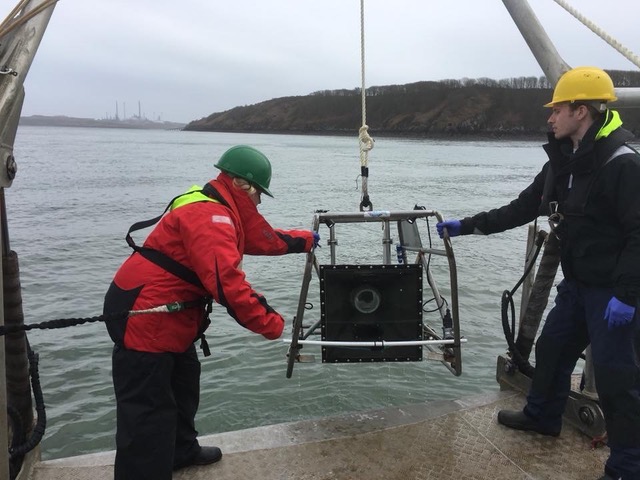These articles are now archived and will no longer be updated.

A Swansea University doctoral student has found a way to view the life of plants and animals in murky waters – by using a lens of freshwater.
Robyn Jones, a PhD student in the College of Science has been testing the lens - a clear liquid optical chamber (CLOC) as a way to improve underwater visibility for scientists researching the flora and fauna that live around our shallow coastal seas. Typically, this equipment will be targeted at assessing fish communities living around marine renewable structures, such as offshore wind, tidal, and wave energy developments, where the waters are typically cloudy.
Robyn said: “It has long been a challenge for scientists to find a way to study biodiversity in these cloudy waters in a way does not disrupt these sensitive and complex habitats. While underwater cameras do help improve our knowledge of the coastal environment, the main drawback is their restricted use in low visibility environments. However, it is vital for us to be able to examine these areas as they are commonly considered critically important for biodiversity, fisheries, energy and increasingly ecosystem services.”
To meet this challenge, Robyn and the team at Ocean Ecology and SEACAMS added a clear liquid optical chamber (CLOC) to a baited remote underwater video (BRUV) system. While similar chambers have been previously used by the marine surveying industry assessment of habitats at the bottom of deep water, adding the CLOC to the BRUV system as a way to assess the movement of fish is new.
The system was tested in both controlled and field conditions with results showing a drastic improvement in visibility - with scientists able to identify fish to species level. Dr Richard Unsworth, Swansea University supervisor on the project said: “Our study showed that by adding the CLOC to a conventional BRUV system, a better level of underwater visibility was possible which can be used for understand difficult marine and freshwater environments such as muddy estuaries and mangroves.”
Robyn said: “With increases in marine renewable developments globally, there is a need to have a simple, reliable, safe, and repeatable method of monitoring the wildlife communities living around these developments. This CLOC‐BRUV system will allow scientists around the world to closely monitor these environments while minimising the risk of damage to the seabed infrastructure.”
This collaborative partnership with marine consultancy company Ocean Ecology Ltd has enabled this new technology to be experimentally field and lab tested in order to demonstrate its validity to government environmental regulators.
Ross Griffin at Ocean Ecology stated “This research is a perfect example of industry and academia working together to develop a novel methodology that can be applied in the real world. It's particularly exciting as it presents an approach to better assess the poorly studied marine biological communities found in low visibility environments not just in the UK but globally”.
The research stems from a collaborative project between SEACAMS 2, Ocean Ecology Limited and Swansea University (part funded by Knowledge Economy Skills Scholarships).
The Swansea University and SEACAMS 2 provided field resources and research staff while Ocean Ecology’s knowledge of the industry and guidance proved critical to the success of the project
